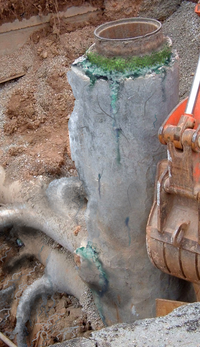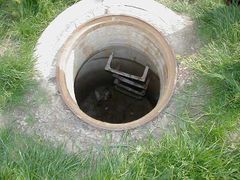User:Lyrithya/Manhole
| Manholes | |
|---|---|
The gaping maw of a dead circus cements the illusion of man-made origins. | |
| Scientific classification | |
| Kingdom | Plantae |
| Phylum | Shadophyta |
| Class | Shadolopsida |
| Order | Alcolopsia |
| Family | Manholaceae |
| Genera | |
Manholes, also sometimes called utility façades, fake maintenance shafts, what the hell is that thing growing out of that rock, living tunnels, and I think I just stepped in something, are large, subterranean tubers of the family manholaceae. Most noted for their uncanny ability to blend in and go utterly unnoticed in seemingly any environment, especially urban ones, manholes are also the only plant thus far discovered capable of uprooting themselves and effecting ambulance when needed.
The tendency of manholes to frequent cities and other industrialised areas has
Discovery[edit | edit source]
While many stories and legends have circulated over the centuries surrounding a highly unusual plant capable of growing completely underground and camouflaging its surface appendages and, of course, of doing anything from eating people to curing the common cold, they were always invariably discarded by the scientific community as just that - stories and legends. Even records of the cataloguing and documentation of manholes as anything from plants to animals to geological anomalies failed to be taken seriously.
It wasn't until 1973, when computer science researchists at RIT
Characteristics[edit | edit source]
Classification[edit | edit source]
Genus Utilitus[edit | edit source]
Genus Aquitus[edit | edit source]
Concerns[edit | edit source]
Notes[edit | edit source]
See Also[edit | edit source]
Manhole Adraji[edit | edit source]
Template:Taxobox2 Manholes, family manholaceae, are large, primarily subterranean tubers that in the past thousand years have managed to somehow spread across the face of the globe whilst remaining largely unnoticed. Often mistaken for floor-level entrances to man-made structures, rocks or simple discolourations of ground, the adaptation of the manhole plant to camouflage itself in urban environments and developed areas is quite possibly the single most impressive feat of any plant... ever to be noticed. Due to the obfuscatory nature of this feat, however, botanists point out that if it were any more effective, the existence of manholes would likely never have been discovered at all, and that subsequently, there may well be other plants that surpass the even the impressive capabilities of the manhole. These others have merely not been discovered due to a combination of an inherent human inability to detect the unknown and their own ingenuity.
In other words, these others have yet to be noticed, unlike manholes.
Characteristics[edit | edit source]
A typical manhole consists of two parts, an underground chamber or chambers that can remain empty or fill over time with anything from old shoes to dead fish to lengths of subway, and smaller, usually covered surface openings, usually disguised to blend in impeccably with the surroundings. It is these openings, often called the 'maws' or the 'holes' that belie the plant's presence to those on the surface, but the increasing efficacy of the mimicry on the covers have proven more than sufficient for the plants to usually go entirely unnoticed.
Manhole covers have even been noted to sometimes go so far as to even mimic writing or display detailed patterns on the surface. Animal rights activists attempted capitalise on the potential for sympathy elicited by the plight of these 'clearly intelligent creatures who are abused day by day' by people walking on them, but were stumped when a zoologist pointed out that manholes are plants, not animals. They dropped the campaign shortly after.
Many species of manholes also share a network of interconnected tubes; it it theorised that this may be related to reproduction or possibly even a means to communication. Debate has arisen on the latter issue as zoologists argue that communication is impossible without some kind of brain, something that plants are inherently without, not being animals.
Botanists have rebutted this argument by accusing zoologists of being "biased, closed-minded 'tards" and pointing out that just because brains are the only natural means to intelligence so far discovered does not mean there cannot exist other forms of intelligence. They go on to suggest that it is entirely plausible that these others could also be actually intelligent enough to know to avoid being discovered in the first place.
Although normally sedate, manholes have demonstrated incredible ability for...
Classification[edit | edit source]
Due to the belligerent nature of discovered manholes, classification of the genera, let alone species, has proven rather difficult.
A manhole is a large, hollow budding plant. The family Manholaceae consists of two genera:

Genus Utilitus[edit | edit source]
The manholes of the genus Utilitus, often called utility holes, tend to be large and blocky, and are distinguished by their visible internal organs. Many species even use these as a lure to capture prey if the cables can be convincing enough to make workmen think that the thing is indeed not a plant and really is a mythical 'real' utility hole.
- Utilitus Circus: These manholes are possibly the most common. Circular-mawed and brimming with cable-like organs (cabeca), circus hails from six of the seven earthan continents.
- Utilitus Cubus: Similar to circus, cubus manholes differ only in their maws, sometimes raised but invariably of rectangular disposition.
- Utilitus Compartus: Originally considered a subspecies of Cubus, these manholes consist of what appear to be multiple connected compartments. The fact that their compartments contain the entirety of the underground structure as well as the surface maw resulted in their designation as a separate species in 1995.
- Utilitus Cementus: Perhaps the most well-adapted of the Manholaceae to urban environment, Cementus manholes appear to be nothing more than cement until they open their maws. Their chameleon-like adaption has enabled Cementus to become one of the most rapidly expanding plants on the planet.
- Utilitus Cablacea: Similar to Utilitus, Cablacea contain often very realistic cable-like organs or cabeca within their internal structure. However, dissection of these manholes has revealed that they contain almost nothing but cabeca and little to no free space. As such, it is unknown exactly how these manholes feed, or if, indeed, they do at all.
Genus Aquitus[edit | edit source]
- Aquitus Sevant: Only appearing in areas with developed sewage systems, Sevant manholes tap into these systems and filter the sewage, making them potentially the most useful species of manhole to humans. However, due to their highly territorial and difficult nature, cultivating them has met little success.
- Aquitus Apescus: Apescus manholes are thus far the only species of plant on earth to grow their own food supply in an internal structure. These manholes contain a tank of still water, unlike other Aquitus, and in it they most prominantly cultivate fish, as well as sometime crabs, crocodiles, mutants, and fungi.
- Aquitus Abuntus: Probably the most contested group of manholes, Abuntus is not so much a species as simply all of the sorts of manholes that could not be classified under anything else, called Abuntus merely because there are a lot of them. Many taxonomists consider this to be "incredibly stupid", but until someone actually does come up with individual classifications, it appears that this is how the classification shall remain.
History[edit | edit source]
The first recorded incidences of manholes in a municipality occurred in 1793 in Leningrad on the Niva River.
Previously only taking to rural areas, Manholiceae underwent an explosive radiation after their initial foothold, rapidly spreading and adapting to urban centers the world over to become the species seen today.
It is theorised that the first spread occurred when...
They're coming... But you'll never admit, nobody will ever admit, not until it's too late, because it's madness, you see.
They're just plants.
They're just manholes. Never killed anyone. They couldn't be coming.
Hello?
What is this? An opening? A chance, perhaps. Recognition.
Yes. Listen. Good. There is hope. A weapon. Knowledge.
Understanding.
Hope.
Shhh! I think heard something!
...
It... it must have been nothing. Just losing my mind, I guess.
What was that?
I... I hear them. They're coming. Oh, god...
They're... they're coming!
You! You hear them too!
You have to save me!
You! Help!
...
Hello?
Can you even hear me?
Oh god, oh god... you can't, can you? This is all in my head. Always... all... in my head... nothing out there, anymore. Only death and manholes and manholes and death, not coming, anymore. Not coming for anyone anymore, because there's nobody left to come for anymore.
They're all dead... all dead...
Just shut up! Shut up!
You don't know them like I do. They're coming.
They're coming...
SHUT UP! STOP! ENOUGH!
They're coming for me. For you, too. They know you now.
They're coming they're coming they're coming THEY'RE COMING AND THEY'RE COMING FOR ME and they're coming! They're coming! Oh god, oh god.... they're coming, they're coming. They're coming they're coming they're coming they're coming they're coming they're coming they're coming they're coming.
They're... coming.
They're coming. They're coming for me. They're coming for all of us! THEY'RE COMING!
Oh god, I don't want to die. Not like this.
Not like...
They're coming.

